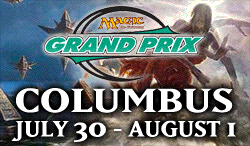It has been a great few months for Too Much Information, and I thank all of you for tuning in. I hope that breaking down the numbers and making this data available has helped in preparing for big events, or just dominating the local FNM. When I first conceived of doing a compilation article, I thought that it would just be slapping together the spreadsheets and crunching the numbers, but it quickly became more than that as I had to standardize the archetype names and make sure that they remained consistent throughout the entire spreadsheet. Changing one deck designation often meant editing over a dozen occurrences of the player’s archetype throughout three worksheets. But enough about the process, here are a few things that you should know about the compiled spreadsheet:
– The spreadsheet includes all of the results from the StarCityGames.com Standard Opens in Atlanta, Philadelphia, Seattle and St. Louis.
– I have also included three PTQs and two Nationals Qualifiers that Star City Games ran in Virginia and West Virginia in May and June.
– During the standardization of Archetype names, many minor archetypes have been eliminated and reclassified. (R/G Spawn became R/G Ramp — Eldrazi Spawn) Many of these changes were simply to match current Archetype names.
– Many sub-archetypes that were not consistently tracked (Polymorph Targets) were eliminated.
– The 18+ vs. 18+ and 15+ vs. 15+ sheets have been combined to a .500+ vs. .500+ worksheet. With 433 lists and almost 1800 results, there is some very interesting data, especially for the top archetypes.
Let’s take a look at the
Spreadsheet
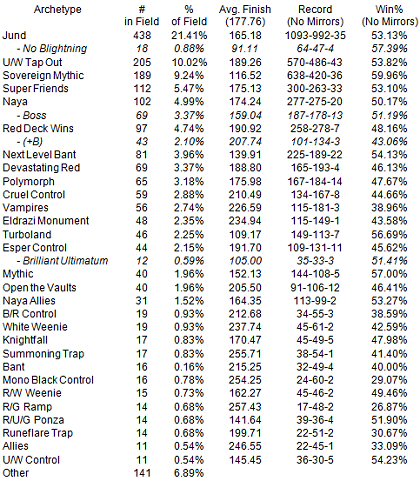
So, the deck choices that people are making are pretty good. The top 5 decks all have win percentages over 50% and there are only three decks that break the 50% barrier with less than 40 representatives in the field. Naya Allies, R/U/G Ponza, and U/W Control all are underrepresented for their performance. U/W Control is a special case as they are very similar to U/W Tap Out, but pack at least 7 counterspells main deck. (Hey, you gotta draw the line somewhere…) The most impressive deck that doesn’t have a spotlight below is traditional Mythic. Its 57% win percentage ranks third in the field behind Sovereign Mythic and Jund without Blightning, but it is worth noting that most of that performance came in Atlanta before players transitioned to Sovereign builds.
I mentioned that the .500+ data shows some interesting changes, but first let me explain what this spreadsheet is. I find all of the matches that are played between players that finish with a record that is at least 1 match over .500. For example, in a nine round event, this sheet will only include matches between players that finished with 15 or more points. (5 wins) In theory, this pinpoints the best decks and players and gives higher quality results. I include this sheet in all of my event spreadsheets, but I rarely do much analysis on it due to the limited number of matches.
Let’s take a look:

Jund is still the most numerous deck, in fact increasing its share, but the win percentage for the juggernaut drops 6% when the top players sit down to battle. The difference for No Blightning versions is even more pronounced, dropping a whopping 18%. U/W Tap Out loses a similar 6% off of its win percentage while increasing its market share slightly.
Enough negativity, who were the winners? How about a 16% win percentage jump for Red Deck Wins leapfrogging everyone and posting a .500+ best 62% win percentage? Red Deck Wins lost a little more than 1% representation, but those players who did perform well did so against the top decks and players. Devastating Red saw a similar, if not as significant, gain adding 8% to its win percentage. Sovereign Mythic lost two percent off its win percentage, but still posted 57% while nearly doubling its representation in the field.
Time to focus in on the match-ups. For the top three archetypes, the .500+ numbers are included, but below the top three decks there aren’t enough matches to draw relevant conclusions.
Jund — 21.41% of the field — Won 53.13% of Matches
(.500+ – 25.00% of the field — Won 47.33% of Matches)
Example:
Standard Build: Joe Bernal, 2nd Place, StarCityGames.com Standard Open — St. Louis, MO — 06/26/10
No Blightning Build: Jeremy Lockridge, 1st Place, StarCityGames.com Standard Open — Seattle, WA — 06/12/10
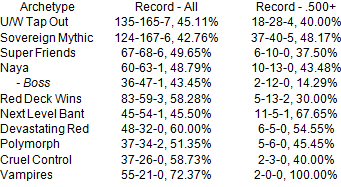
Wow, what a difference three months makes — from powerhouse to punching bag. Jund has been underperforming the last few events, but it was not until I looked at all of the numbers together that it became clear that Jund is not remotely the terror that it was. You have to go down to Red Deck Wins to find a winning record, and even that one falls apart when the top players play. Jund is currently an excellent example of a deck that beats anything below tier 1, but only has some game against the top of the field. It is a great deck for doing well at an event, but it looks like it should no longer be your weapon of choice to try to win one.
U/W Tap Out — 10.02% of the field — Won 53.82% of Matches
(.500+ – 10.88% of the field — Won 47.44% of Matches)
Example:
Standard Build: Shaheen Soorani, 1st Place, PTQ Amsterdam — Roanoke, VA — 06/13/10
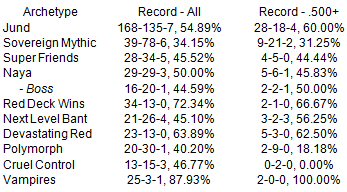
U/W Tap Out clearly has a strong place in the metagame, but a striking problem with Sovereign Mythic is a major concern that doesn’t get any better in the .500+ numbers. U/W Tap Out seems to have stabilized the Jund match-up in its favor and continues to dominate the Mono Red Builds and Vampires. The Polymorph match-up is an interesting issue as Polymorph decks have been popular but not made much noise. Perhaps the answer to that match-up and a way to even out the Sovereign Mythic battle is main decking some more instant speed removal.
Sovereign Mythic — 9.24% of the field — Won 59.96% of Matches
(.500+ – 17.13% of the field — Won 57.65% of Matches)
Example:
Standard Build: Brian Edgar, 3rd Place, StarCityGames.com Standard Open — St. Louis, MO — 06/26/10
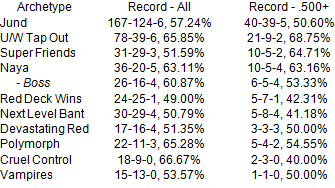
Sovereign Mythic is clearly the deck to choose from this two month stretch. An almost 60% win percentage since its emergence is staggering and it holds up well when the top players face off. Sovereign Mythic had the highest percentage of top players, it had the highest win percentage and had the most top eight performances comprising almost one quarter of the top eight participants. (17 of 72, Jund had 14) All in all, Sovereign Mythic makes a very strong case for being the clear cut best deck.
Super Friends — 5.47% of the field — Won 53.10% of Matches
(.500+ – 5.32% of the field — Won 52.08% of Matches)
Example:
Standard Build: Chris Wallace, 3rd Place, PTQ Amsterdam — Roanoke, VA — 06/12/10
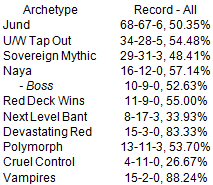
When Super Friends burst onto the scene in Atlanta, it looked as if it would storm in and take over U/W Tap Out’s position as the top control deck, but it was not to be. Since that event, it has posted strong, but not eye popping, results as it took its place as a niche version of control. A weaker match-up against Jund is definitely an issue, but a stronger, if still under 50% match-up with the new bully Sovereign Mythic may be a reason to revisit this deck as the metagame shifts.
Naya — 4.99% of the field — Won 50.17% of Matches
(.500+ – 4.40% of the field — Won 51.08% of Matches)
Example:
Boss Build: Kevin Ambler, 6th Place, StarCityGames.com Standard Open — Seattle, WA — 06/12/10
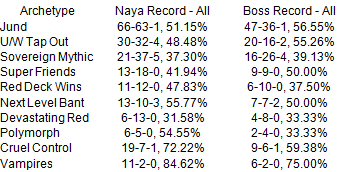
First, let me clarify what I use the “Boss” designation for: the Boss sub-archetype uses Stoneforge Mystic with two or more equipment to search out, usually Basilisk Collar and Behemoth Sledge. Against the most popular decks, the Boss sub-archetype performs better, but drops a few more games to Red Deck Wins and tier 2 decks such as Polymorph and Cruel Control. Naya, specifically the Boss variety, was developed to combat a metagame overrun with Jund and that is no longer where we are. As such, the archetype is treading water, but hasn’t been putting up any impressive numbers recently.
Red Deck Wins — 4.74% of the field — Won 48.16% of Matches
(.500+ – 3.47% of the field — Won 62.10% of Matches)
Example:
Standard Build: Joey Mispagel, 1st Place, StarCityGames.com Standard Open — St. Louis, MO — 06/26/10
(+B) Build: Gregory Bowers, 14th Place, PTQ Amsterdam — Richmond, VA — 05/08/10
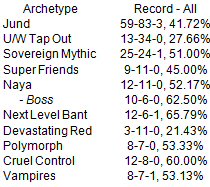
I have dogged Red Deck Wins in the past and the basic numbers are not very impressive, but the 15 RDW players who had good days really knocked it out of the park when they were across from the other top players. Red Deck Wins posts the highest win percentage of any deck in any portion of this article with a 62% (37-22-3) in the .500+ sheet. That includes 13-5-2 against Jund and 7-5-1 against Sovereign Mythic, so the top RDW players have figured out how to tip those match-ups in their favor, even if the average RDW player has not. After some hot press after GP: Malaysia, adding black for Blightning has fallen from favor and not returned positive results.
Next Level Bant — 3.96% of the field — Won 54.13% of Matches
(.500+ – 4.17% of the field — Won 46.77% of Matches)
Example:
Standard Build: Calosso Fuentes, 4th Place, PTQ Amsterdam — Roanoke, VA — 06/13/10
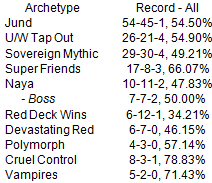
Next Level Bant looks like it is well placed in the metagame with positive and even match-ups across the board but it seems to fall off when the top players face off. The Jund match-up shifts 20% in Jund’s favor but the Sovereign Mythic match-up actually slid Next Level Bant’s direction. As a relatively new deck, Next Level Bant is in a good enough place in the metagame to continue to evolve and find its niche.
Devastating Red — 3.37% of the field — Won 46.13% of Matches
(.500+ – 2.31% of the field — Won 54.65% of Matches)
Example:
Standard Build: Phillip Li, 6th Place, StarCityGames.com Standard Open — Philadelphia, PA — 06/05/10
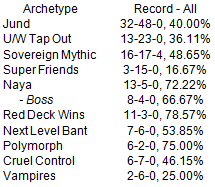
For a deck that burst onto the scene in Atlanta, Devastating Red has not picked up much steam since. It rolls over Naya and its cousin Red Deck Wins, but hits the same brick wall from U/W Tap Out and Super Friends. Devastating Red saw a similar bump to its record when top players sit down, suggesting that skilled pilots can get more out of the deck. Unfortunately, as long as U/W Tap Out is a significant player, I can’t recommend this deck as your day ends early if you see a turn 2 Wall of Omens.
Big Finish!
One of the topics that has been bouncing around the office this past week has been about the difference between saying that you are serious about earning a PTQ slot and what your actions show. It bears mentioning up front that I have never been serious about winning a PTQ myself, but I have seen a lot of people try and had a lot of people tell me that they were getting serious about it. Here are some of my measures of whether you actually are serious or if you are just talking about it and lying to yourself:
1 — Do not limit your deck choice.
So many players have ‘pet’ decks, colors, or strategies. If you can’t get beyond an “I am a Red player” mentality then you aren’t ready to be serious. Don’t get me wrong, you could get lucky and the Red deck might be the right choice at one event, but that doesn’t mean that you did anything right. The same goes for Green, Black, Elves, Combo, Aggro, etc.
2 — Be able to explain your deck choice
Good players can tell you why they are playing a certain deck. This means that you know the metagame, the match-ups and have chosen your deck because of that knowledge, not in spite of it. I hope that these articles can help you in accomplishing this step, but every area is different, so make sure that you are in touch with the local metagame as well.
3 — Test with your deck of choice for at least the week leading up to the event.
I see players scrambling for a deck the night before an event or even the morning of and it blows my mind. As evidenced by the shift in numbers in the .500+ sheet, there are clearly differences in how the good players handle certain decks and match-ups. Those don’t come from testing from 11:00 pm to 3:00 am the night before the event.
4 — Set aside the “pride” of bringing your own deck.
Decks that win large events like the StarCityGames.com Opens or Grand Prix are good. Probably great, even. At worst, they are a great starting point. Now I know that a lot of people are going to scream “Net-Decking!”, but let me point something out: you hate it because it works. If you were beating the people doing it, you would not be complaining. If you want to prove your mettle as a deck builder, perfect the great list that you got from the last big tournament. Starting from scratch is simply asinine. By standing on the shoulders of giants, we may see further and reach further than the giants themselves.
It essentially breaks down to this: There are plenty of hurdles between you and winning a PTQ. Do not add to them with your own hang ups.
I hope you all enjoyed the compilation. I will be working hard over the weekend to finish the Legacy article to help everyone prep for GP: Columbus and I am looking forward to a great event there and at GenCon before we get back to the StarCityGames.com Open Series in Denver (August 21-22) and Minneapolis! (August 28-29) See you at the events!

